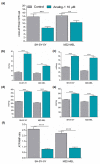Targeting of Ubiquitin E3 Ligase RNF5 as a Novel Therapeutic Strategy in Neuroectodermal Tumors
- PMID: 35406574
- PMCID: PMC8997491
- DOI: 10.3390/cancers14071802
Targeting of Ubiquitin E3 Ligase RNF5 as a Novel Therapeutic Strategy in Neuroectodermal Tumors
Abstract
RNF5, an endoplasmic reticulum (ER) E3 ubiquitin ligase, participates to the ER-associated protein degradation guaranteeing the protein homeostasis. Depending on tumor model tested, RNF5 exerts pro- or anti-tumor activity. The aim of this study was to elucidate the controversial role of RNF5 in neuroblastoma and melanoma, two neuroectodermal tumors of infancy and adulthood, respectively. RNF5 gene levels are evaluated in publicly available datasets reporting the gene expression profile of melanoma and neuroblastoma primary tumors at diagnosis. The therapeutic effect of Analog-1, an RNF5 pharmacological activator, was investigated on in vitro and in vivo neuroblastoma and melanoma models. In both neuroblastoma and melanoma patients the high expression of RNF5 correlated with a better prognostic outcome. Treatment of neuroblastoma and melanoma cell lines with Analog-1 reduced cell viability by impairing the glutamine availability and energy metabolism through inhibition of F1Fo ATP-synthase activity. This latter event led to a marked increase in oxidative stress, which, in turn, caused cell death. Similarly, neuroblastoma- and melanoma-bearing mice treated with Analog-1 showed a significant delay of tumor growth in comparison to those treated with vehicle only. These findings validate RNF5 as an innovative drug target and support the development of Analog-1 in early phase clinical trials for neuroblastoma and melanoma patients.
Keywords: RNF5; endoplasmic reticulum associated protein degradation; melanoma; neuroblastoma; ubiquitin ligase.
Conflict of interest statement
The authors declare no conflict of interest.
Figures






References
-
- Ciechanover A.A.H. No Title THE UBIQUITIN SYSTEM. Annu. Rev. Biochem. 1998;67:425–479. - PubMed
-
- Didier C., Broday L., Bhoumik A., Israeli S., Takahashi S., Nakayama K., Thomas S.M., Turner C.E., Henderson S., Sabe H., et al. RNF5, a RING Finger Protein That Regulates Cell Motility by Targeting Paxillin Ubiquitination and Altered Localization. Mol. Cell. Biol. 2003;23:5331–5345. doi: 10.1128/MCB.23.15.5331-5345.2003. - DOI - PMC - PubMed
Grants and funding
LinkOut - more resources
Full Text Sources

